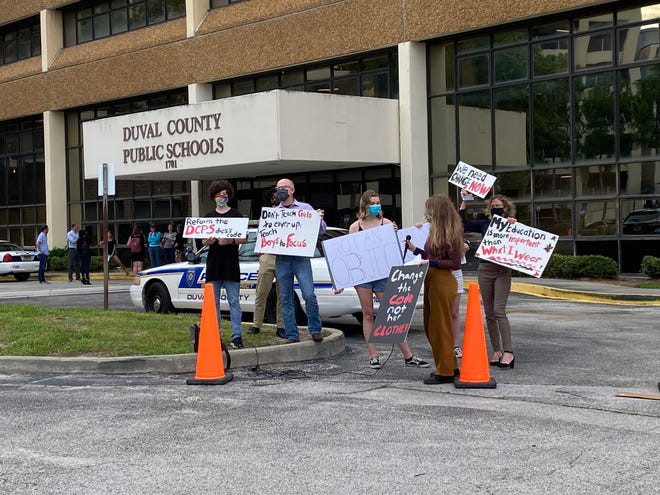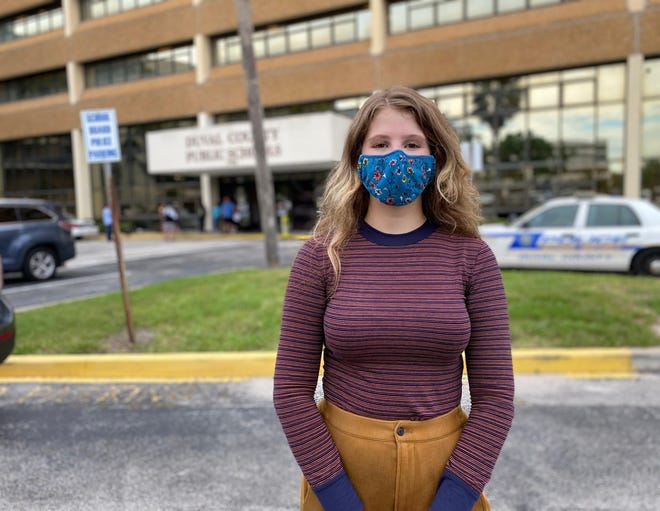
Exclusive: ‘My skin isn’t distracting’ — How Duval Schools students feel about the dress code
Florida Times-Union | By Emily Bloch | May 17, 2022
“Sexualized.” “Shoulders.” “Knees.” “Distracting.”
Those are some of the terms most often used by Duval County high school students when asked about the district’s dress code measures, according to comments collected from about 3,200 high school students by Duval County Public Schools.
In recent years — in light of the Me Too movement and social justice issues — young people have gone public about their issues with dress codes they say are sexist. Many say the dress code is inequitable when it comes to enforcement for boys versus girls.
Now, for the first time, school district officials have provided a formal outlet to let students express their frustrations.
Earlier this school year, Duval Schools rolled out a digital platform for students to discuss problems they have with the dress code and changes they would like to see made. The platform, ThoughtExchange, is a new form of data management software that lets students discuss a topic anonymously and “rate” comments they agree with, similar to ‘liking’ on Facebook or upvoting. Creators of the platform say it’s an unbiased way to hear from everyone. It sort of works like Reddit, but in an anonymous, controlled environment.
Fear-mongering will thrive without dress code reform, one student said
Results show that common themes among participants included opinions that the code and its enforcement are “sexist,” “impact girls more” and that penalties varied depending on body type. Participation demographics only included what grade a student was in, not the school they attend or their gender.
“The beauty of this is it’s anonymous,” said Duval Schools Chief of Marketing and Communications Tracy Pierce. “In town halls, strong personalities often take over. Here, you get a broader, probably more accurate determination of how a community is thinking about an issue.”
Current Duval Schools dress code forbids tank tops, halter tops, spaghetti strap tops and strapless tops, but students say enforcement varies and that boys are held to looser standards.
“It [the dress code] needs to be made less focused on targeting young women as sexual objects,” one student wrote. “I have been dress coded multiple times at school and was told it was because it was distracting. My skin isn’t distracting. Disrupting my education because of holes in my jeans, my shoulder or midriff showing, is!”
Students said they wanted the opportunity to express themselves through their clothes as well as the ability to be comfortable in Florida’s heat. Hundreds of comments mentioned things like “showing shoulders,” “stomach,” “leggings and shorts.”
“My skin isn’t distracting. Disrupting my education because of holes in my jeans, my shoulder or midriff showing, is!”
A COMMENT SUBMITTED BY A DUVAL COUNTY PUBLIC SCHOOLS HIGH SCHOOL STUDENT THROUGH THE DISTRICT’S ANONYMOUS SURVEY.
Kennedy Murphy, a rising junior at Stanton College Preparatory School, recalls studying all night for a test, waking up in a hurry and throwing on leggings and a band T-shirt. She was dress coded and told she couldn’t take the test until she changed because her shirt didn’t go past her hips while wearing athletic tights.
“This girl could be me, it could be you,” she said to a crowd at a dress code protest she organized earlier this school year. “Until the dress code is reformed fear-mongering will thrive in our schools.”
Students said Florida’s heat should be better taken into consideration when it comes to what is allowed.
Currently, shorts, skirts and dresses are allowed, granted that their length is not “disruptive or destructive, as determined by the school administration,” district policy says. Students say they want leniency when it comes to length and shoulders being exposed — especially on Florida’s hottest days, which can climb into the 90’s.
“The Florida weather and the dress code do not go together,” another student wrote. “The lack of ability for people to wear shorts and certain shirts in the weather causes more distractions for people than the shirts and shorts.”
Another student said, “I should be able to wear a tank top or shorts when it’s hot out.” One simply asked for “leniency on tank tops.” “We live in Florida,” they wrote. “It tends to be very hot in the spring and summer.”
Duval student dress code protests prompted district outreach

At the beginning of this school year, Murphy organized a protest in front of the school board building, pushing for dress code reform. In the fall, students at several schools across Jacksonville organized and participated in walkouts where they purposefully broke dress code policies and pushed boundaries to point out inequity. Boys wore mini skirts and crop tops, girls wore spaghetti straps or purposefully showed their shoulders.
It’s partly what prompted the district to produce the ThoughtExchange survey.
The district paid $48,000 for ThoughtExchange last December, public records show. So far, officials have used the software for internal surveys among staff and to get input from teachers on different issues.
For example, last year, Duval Schools teachers used ThoughtExchange to suggest how they wanted to see federal COVID-19 relief funding spent in the classroom.
But this marked the first time the technology was used by students.
Of Duval Schools’ roughly 30,000 high school students, all were emailed and encouraged to partake in the survey. About 10 percent participated (3,175) with a mostly even split between 9th, 10th, 11th and 12th-graders. Students were not asked to disclose their gender.
Top-ranked comments, with the most interaction from peers and highest ratings, were compiled by ThoughtExchange into a report for district officials to review, along with information on common themes mentioned by students.
“When I first started at the district in 2018 we did research about communication. Everyone wanted more two-way communication. But how do you do that with over 120,000 people?” Pierce said. “We found this tool so when the dress code came up, [Superintendent] Dr. Greene suggested using it to hear what students have to say.”
Tracy said that oftentimes, traditional surveys fail to provide the right questions. In this case, the student community was able to contribute answers, have discussions and rate replies. The prompts were left up for a week for students to participate. Ultimately, students submitted over 3,500 responses (students could add multiple discussion points and comments) and awarded more than 44,000 ratings on comments that resonated with them. Pierce ultimately spent three days going through all of the replies.
“The overall theme is that students would like to see the dress code change and in lots of ways,” he said. “
Tracy presented the results to the school district’s leadership team, along with principals, teachers, parents and student groups. The school district’s Parent-Teacher Association (PTA) has also gotten involved, with members expressing concerns over subjective dress code enforcement.
The PTA introduced a resolution to the school board pressing for the dress code to be more generalized, removing references to clothing that could be interpreted as discrimination on the base of gender, race or religion.
“The dress code contains subjective language that lends itself to different interpretations,” the resolution said. “Example[s include] ‘distracting,’ ‘form-fitting,’ ‘overly tight,’ etc.”
The district’s annual code of conduct review process — which includes dress code policy — is underway and expected to wrap up later this summer.
Next up, a community stakeholder group will receive the survey information and make final recommendations to the superintendent.
Murphy takes the actions that culminated over the last school year — including student-organized protests, the district-wide student survey and PTA’s involvement — as steps in the right direction. Though, she admits, it’s not perfect.
“While students are definitely still upset with the dress code, I feel like the situation … has improved since the beginning of the year,” she said. “Overall, I think the situation has improved, but there is still a lot of room for change.”





